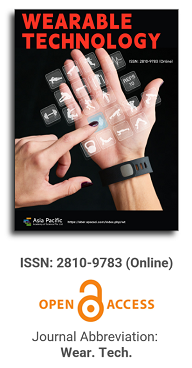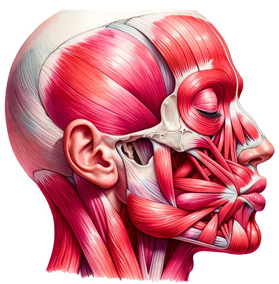

This paper delves deeply into the innovative realm of integrating human emotions with wearable technology. The primary focus is on the conceptualization and development of a kiss transfer device that harnesses the power of wearable technology to bridge the physical gap in human-human interactions. By investigating the intricate nuances of the human-human kissing process, the research seeks to replicate this intimate gesture through a technological medium. The paper not only elaborates on the anatomy, evolution, and hormonal dynamics of kissing but also underscores the transformative potential of wearable technology in capturing and transmitting these intimate moments. This exploration opens up new horizons for long-distance relationships, offering a tangible touchpoint that goes beyond traditional communication methods. Through this pioneering work, the research positions wearable technology as not just a tool for communication but as an extension of our human emotions and expressions.

Wearable low back trainer combined with massage in the treatment of chronic nonspecific low back pain
Vol 3, Issue 2, 2022
Download PDF
Abstract
Objective: To observe the clinical effect of wearable low back trainer combined with massage in the treatment of chronic non-specific low back pain. Methods: A total of 56 chronic nonspecific low back pain patients were randomly assigned to three groups. The ob group (n=19) was treated with wearable device treatments based on massage for two weeks, once a day, eight minutes each time, five times a week, while the control group (n=19) received massage only for two weeks, once a day, 20 minutes each time, and the blank group (n=18) rest only with closely observation. The therapeutic effect of three groups were evaluated by VAS and ODI scores before the treatment, one week after treatment and two weeks after treatment respectively. Results: There was no significant difference in the VAS score between the observation group and the control group before treatment (P>0.05) while the VAS score difference between the three groups after one week and two weeks of treatment were statistically significant (P<0.05). The VAS scores of the observation group and the control group showed a downward trend with time. After 2 weeks of treatment, the VAS value of the observation group decreased significantly more than the control group, and the difference was statistically significant (P<0.05). The decrease of VAS value in the group was significantly greater than that in the blank group, and the difference was statistically significant (P<0.05). There was no significant difference in the ODI score between the observation group and the control group before treatment and after 1 week of treatment (P>0.05). However, there was a statistically significant difference in the ODI score between the three groups after 2 weeks of treatment (P<0.05). The changing trends of ODI values in the three groups were different and both the observation group and the control group showed a downward trend. After two weeks of treatment, the ODI values of the observation group decreased significantly more than the control group with statistically significant differences (P<0.05). However, the ODI value of the blank group decreased after 1 week of treatment and increased again after two weeks of treatment. Conclusion: The use of the wearable low back trainer combined with massage therapy has a better therapeutic effect on chronic non-specific low back pain and can relieve pain more effectively than just simple massage therapy alone.
Keywords
References
- Falavigna A, De Bragagl, Monterio GM, et al. The epidemiological profile of middle-aged population with low back pain in southern Brazil. Spine 2015; 40(5): 359–365.
- Shen Z, Wang Y, Wu Z. Research progress of non-specific low back pain assessment scale, pathogenesis and diagnosis and treatment. Chinese Journal of Clinicians 2017; 45(8): 16–19.
- Terasa P, Carmine A, Walter C, et al. Chronic low back pain and postural rehabilitation exercise: A literature review. Journal of Pain Research 2019; 12(5): 95–107.
- Koes BW, Bouter LM, Beckerman H, et al. Physiotherapy exercises and back pain:A blinded review. BMJ 1991; 302(6972): 1572–1576.
- Koes BW, Van Tulder MW, Ostelo R, et al. Clinical guidelines for the management of low back pain in primary care: An international comparison. Spine 2001; 26(22): 2504–2514.
- Furlan AD, Brosseau L, Imamura M, et al. Massage for low-back pain: A system atic review within the framework of the Cochrane Collaboration Back Review Group. Spine 2002; 27(17): 1896–1910.
- He C, Ding M. Clinical evidence-based rehabilitation of non-specific low back pain. National Clinical Rehabilitation 2002; 6(14): 2026–2034, 2046.
- Liu Y, Wu J. Rehabilitation treatment and progress of non-specific low back pain. Anhui Medicine 2010; 14(9): 1103–1106.
- Chen L, Wang J. Research progress on exercise therapy for low back pain. Chinese Journal of Rehabilitation Medicine 2008; 23(4): 276–279.
- Chou R, Qaseem A, Snow V, et al. Diagnosis and treatment of low back pain: A joint clinical practice guideline from the American College of Physician and American Pain Society. Annals of Internal Medicine 2007; 147(7): 478–491.
- Wang B. Clinical and rehabilitation of non-specific low back pain. Chinese Journal of Rehabilitation Medicine 2004; 19(2): 150–153.
- Zheng G, Zhao X, Liu G, et al. The reliability of the Oswestry disability index in assessing patients with low back pain. Chinese Journal of Spinal Cord 2001; 12(1): 13–15.
- Fairbank JC, Pynsent PB. The Oswestry disability index. Spine 2000; 25(6): 2940–2952.
- Liu Z, Qiu Y. Internationalization of the Oswestry disability index in patients with low back pain application status. Chinese Journal of Spinal Cord 2008; 18(8): 550–553.
- Miao H. Theory and Practice of Rehabilitation Medicine. Shanghai: Shanghai Science and Technology Press, 2000, pp.1702 1709.
- Liu Q, Mai M, Xiao L, et al. Validity analysis of Oswestry disability index in assessing patients with chronic low back pain. Chinese Journal of Rehabilitation Medicine 2010; 25(3): 228–231.
- Liu Q, Mai M, Xiao L, et al. Chinese version of the Oswestry disability index to assess the responsiveness of patients with chronic low back pain. Chinese Journal of Rehabilitation Medicine 2010; 25(7): 621–624.
- Zhang H, Yu Z. The development of intelligent wearable medical equipment. Medical Equipment 2017; 10(30): 203–204.
- Wu J, Li S, Hu X, et al. Empirical study on factors influencing the integration intention of users of health wearable devices. Journal of Information Resource Management 2017; (2): 22–30.
- Jia Z, Wang W, Wang C, et al. Application development of wearable devices in the medical field Exhibition. China Medical Equipment 2017; 32(2): 96–99.
- Lu Y, Xie H. The application of wearable devices in the medical field. China Journal of Medical Devices 2017; 41(3): 213–230.
- Qiu J, Xia Q, Fang Y, et al. Research on the application status of sensors in rehabilitation medicine. Chinese Journal of Rehabilitation 2017; 27(3): 61–64.
- Qiao J, Hu H. Research hotspots and trend analysis of wearable devices. Chinese Medicine Journal of Library and Information Science 2017; 26(11): 49–52.
- Xie L, Shi P, Cai W. Key technologies and development trends of wearable smart devices. Heilongjiang Science and Technology Information 2015; (28): 135–136.
- Van Tulder MW. Treatment of low back pain: Myths and facts. Schmerz 2001; 15(7): 499–503.
- Hu K, Chen X, Zhang S, et al. Research and application of wearable devices in rehabilitation medicine in developed countries. China Digital Medicine 2013(8): 56–59, 15.
- Xu X, Ai S. The application status and prospect of wearable devices in the field of rehabilitation. World Latest Medical Information Digest 2018; 18(5): 27–28.
- Chen L, Li J. The development of Chinese rehabilitation medicine. Journal of Rehabilitation 2015; 25(1): 2–5.
- Wen D, Lei J. Application and problems of wearable devices in the medical and health field. China Digital Medicine 2017l; 12(8): 26–28, 115.
- He X, Qian Q, Wu S, et al. Data privacy of health and medical wearable devices research on related issues. Chinese Hospital Management 2017; 10(37): 68–70.
- Qin Q, Li W, Zhu S, et al. Current status and future development of wearable devices. Journal of Nanjing Medical University (Natural Science Edition) 2017; 37(2): 149–153, 230.
Supporting Agencies
Copyright (c) 2022 An Cao, Guozhi Huang, Qing Zeng, Peichen He, Rihui Li

This work is licensed under a Creative Commons Attribution 4.0 International License.

Prof. Zhen Cao
College of Information Science & Electronic Engineering, Zhejiang University
China, China
Processing Speed
-
-
-
- <5 days from submission to initial review decision;
- 62% acceptance rate
-
-
Asia Pacific Academy of Science Pte. Ltd. (APACSCI) specializes in international journal publishing. APACSCI adopts the open access publishing model and provides an important communication bridge for academic groups whose interest fields include engineering, technology, medicine, computer, mathematics, agriculture and forestry, and environment.





